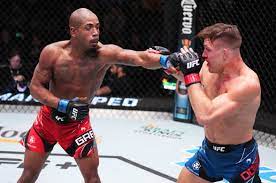What’s the Deal with MMA Fighters?

Like many people who have started training a martial art like Muay Thai or boxing, your coach has likely spent the last few months telling you things like, “keep your hands up”, “you are dropping your left on the roll”, “bring your hands back to your face after each punch”, etc.. You practice these techniques diligently, develop good fundamentals and then one day your friends invite you over for a UFC night. Surrounded by your training partners and armchair experts, you begin watching and inevitably, the thought enters your mind, “why do they keep their hands so low and why does their technique look sloppy?” After all, these are professionals at the highest level of their game… surely they must know this.
So what’s the deal with MMA fighters? First off, it’s very important to understand that every time you add a rule to a Martial Art, you remove that art further and further from what we would call self-defense.
For example, here is a list of things deemed illegal in the UFC:
Strikes to the back of the head, neck, throat, spine, kidneys, groin
Biting, pulling hair or eye gouging
Fish hooking
Head butting
Pile Driving
Stomp kicks
Kicks or knees to the head of a grounded opponent
Small joint manipulation
Intentional breaking of bones (not giving opponents time to tap)
And of course the infamous 12 to 6 elbow
The astute reader may notice that most of these rules tend to limit the striker more than the grappler and give the grapplers advantages in getting takedowns and staying safe while on the ground. However there is another rule that swings these advantages back towards the striker. Rounds.
It takes time to secure a take down. It is a dangerous move to make against a trained striker and done incorrectly can lead to some of the most brutal knockouts imaginable. Knees up the middle, uppercuts and strikes when recovering from a failed takedown can spell doom for many grapplers. So once a takedown is secured, it is crucial for the grappler to get to work chasing a submission or ground and pound finish. Anyone that has tried wrestling or Jiu Jitsu will know that it also takes time to gain position, control, and then a submission. Often the round ends before this is accomplished and this puts both fighters back on their feet for the next round. Rinse and repeat for the grappler but takedowns only get harder as you become tired, less explosive and you both become more sweaty.
If rounds were removed from MMA, you would likely see a lot more grapplers winning. If you removed the striking limitations from the rules you would likely see more strikers winning. Remove all these rules and you have combat on a level of violence that most sponsors can’t stomach. For anyone that is not convinced of this, we recommend you go back and watch UFC 1-10 where the rules were almost non-existent (think repetitive groin strikes from side mount and kicks to face of downed opponents). Furthermore, in these early UFC fights there were no rounds. It was literally a fight til you drop or cannot continue. There were no weight classes and it was fought in a tournament style where fighters would compete multiple times in one night… regardless of injuries. For all of its brutality, these early UFC events likely taught the world more about martial arts than all the books, theory and myths put together until this point.

So if you are still wondering why professional MMA strikers are more likely to fight with their hands low or why grapplers aren’t chasing submissions in the same way you were taught in BJJ class, it’s because of the rule sets. For example, strikers need to defend takedowns and keeping their hands lower will make it easier to get underhooks and grapplers needing to contend with elbows, from the bottom position, have to change their game plan as well. These are things that will not be drilled in your typical Muay Thai or BJJ class. However, if you then watch a professional Muay Thai fight or a BJJ competition, you will see why it was drilled that way in class. Ultimately, understanding why you are training and what your goals are will help you develop your style around your goals. If you want to box, train like your coach tells you. If you want to compete in BJJ, train like your coach tells you. If you are training for self defense, understand that rule sets will limit your options and won’t always be the most effective way of keeping you safe.
If you are interested in starting or continuing your martial arts journey or learning more about self-defense, come check us out at Northwest Fighting Arts in Portland Oregon. Call anytime to 503 235 3435 and we will set you up with a free introductory lesson. Be well!



